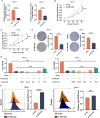HECTD2 as a target for veratric acid in the regulation of ferroptosis in renal cell carcinoma
- PMID: 39343853
- PMCID: PMC11439856
- DOI: 10.1007/s00726-024-03419-0
HECTD2 as a target for veratric acid in the regulation of ferroptosis in renal cell carcinoma
Abstract
Function of HECTD2 in renal cell carcinoma malignant progression is undefined. Molecular mechanism behind anti-cancer effects of veratric acid (VA) from traditional Chinese medicine (TCM) is underexplored. The Cancer Genome Atlas was leveraged to study HECTD2 expression in renal cell carcinoma and its relationship with histological grading. Kaplan-Meier survival analysis was performed. HECTD2 expression was detected in cancer cells and tissues via qRT-PCR and immunohistochemistry. GPX4 and SLC7A11 expression in tumor samples with high or low HECTD2 expression was examined by immunohistochemistry, cell viability by CCK8, cell proliferation by colony formation assay, lipid ROS and mitochondrial superoxide levels by flow cytometry, Fe2+ and MDA content by assay kits, and GPX4 and SLC7A11 proteins by western blot. SeeSAR software screened TCM small molecule compounds with highest affinity to HECTD2, confirmed with cellular thermal shift assay. VA IC50 was measured by CCK8. Xenograft model was developed and treated with VA. Tumor size and weight were monitored, with immunohistochemistry to detect HECTD2 expression in tumors and assess ferroptosis-related markers. HECTD2 was overexpressed in tumor tissues and cells, which positively correlated with histological grading. HECTD2 depletion inhibited cell vitality and proliferation, raised intracellular lipid ROS, mitochondrial superoxide, Fe2+, and MDA. HECTD2 was a target with highest VA affinity. In vitro and vivo experiments concurred that VA treatment hindered malignancy of renal cell carcinoma and enhanced its susceptibility to ferroptosis. HECTD2 supports ferroptosis resistance in renal cell carcinoma, but VA, through its targeting of HECTD2, initiates ferroptosis, showcasing its anti-cancer efficacy.
Keywords: Ferroptosis; HECTD2; Renal cell carcinoma; Traditional Chinese medicine; Veratric acid.
© 2024. The Author(s).
Conflict of interest statement
The authors have no conflicts of interest to declare.
Figures






Similar articles
-
TRIB3 knockdown increases the sensitivity of clear cell renal cell carcinoma to sunitinib by inducing ferroptosis.Cell Signal. 2024 Dec;124:111421. doi: 10.1016/j.cellsig.2024.111421. Epub 2024 Sep 17. Cell Signal. 2024. PMID: 39299601
-
Ponicidin triggered ferroptosis in esophageal squamous cell carcinoma by suppressing the SLC7A11/Glutathione/GPX4 signalling axis.Phytomedicine. 2025 Jul 25;143:156925. doi: 10.1016/j.phymed.2025.156925. Epub 2025 May 28. Phytomedicine. 2025. PMID: 40456202
-
Picropodophyllin induces ferroptosis via blockage of AKT/NRF2/SLC7A11 and AKT/NRF2/SLC40A1 axes in hepatocellular carcinoma as a natural IGF1R inhibitor.Phytomedicine. 2025 Jul 25;143:156840. doi: 10.1016/j.phymed.2025.156840. Epub 2025 May 10. Phytomedicine. 2025. PMID: 40412057
-
Icariside II induces ferroptosis through the down-regulation of SLC7A11 in ovarian cancer.J Ovarian Res. 2025 Apr 5;18(1):71. doi: 10.1186/s13048-025-01650-1. J Ovarian Res. 2025. PMID: 40186304 Free PMC article.
-
IGF2BP3 suppresses ferroptosis in lung adenocarcinoma by m6A-dependent regulation of TFAP2A to transcriptionally activate SLC7A11/GPX4.Mol Cell Biochem. 2025 Apr;480(4):2361-2375. doi: 10.1007/s11010-024-05068-z. Epub 2024 Jul 18. Mol Cell Biochem. 2025. PMID: 39026029
References
-
- Bahadoram S, Davoodi M, Hassanzadeh S, Bahadoram M, Barahman M, Mafakher L (2022) Renal cell carcinoma: an overview of the epidemiology, diagnosis, and treatment. G Ital Nefrol. 39:2022 - PubMed
-
- Bernassola F, Chillemi G, Melino G (2019) HECT-Type E3 ubiquitin ligases in cancer. Trends Biochem Sci 44:1057–1075 - PubMed
MeSH terms
Substances
Grants and funding
- 2023SZZ004/Science and Technology Bureau of Deyang City, Project Funding of Social Development
- 2023SZZ004/Science and Technology Bureau of Deyang City, Project Funding of Social Development
- FHS202301/Deyang People's Hospital 2023 Hospital Incubation Project
- ZQY2023ZX02/Sichuan Provincial Key Chinese Culture Research Institute - Tibetan and Qiang Yi Culture Research Institute Key Project Funding
LinkOut - more resources
Full Text Sources
Medical

